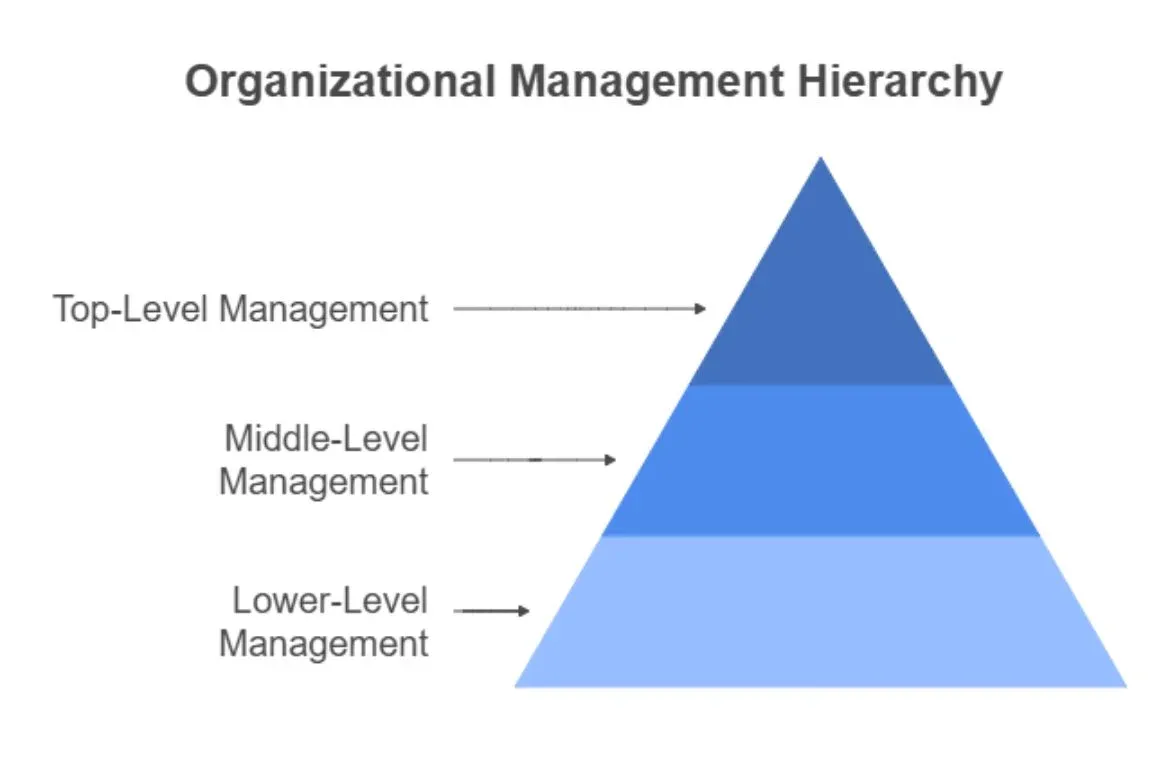Understanding the Three Levels of Management in an Organization

Most companies have three distinct management levels. Top executives shape strategic decisions at the highest level. Middle managers turn these strategies into practical plans. Lower-level managers run day-to-day operations. Each tier plays a vital role in the company's structure. Their unique responsibilities and authority levels help drive success and keep the business sustainable.
Management structures help organizations run smoothly and achieve their goals. A chain of command that spans different management levels allows companies to coordinate everything from big-picture planning to everyday tasks.
What Are the Three Levels of Management?

Management levels create clear boundaries between different positions in an organization's structure. Top-level, middle-level, and lower-level management make up these three tiers. Each tier has its own duties, roles, and decision-making power within the organization.
These management layers work together as one system. Information and directions flow up and down the chain. Senior leaders focus on long-term planning while lower levels handle day-to-day operations. Different companies might use different names for these levels. Senior or executive management can refer to top-level positions.
Middle-level managers may be referred to as executive management. Supervisory, operative, or first-line management are other names for lower-level management.
Organization size and complexity determine the number of management layers. Big companies might add extra layers like lower-middle or upper-middle management to better handle communication and responsibilities. The main duties stay the same even when titles change.
Top-Level Management: CEO, CFO, and Strategic Leaders
Top executives sit at the peak of an organization's structure. This group includes C-suite leaders like the Chief Executive Officer (CEO), Chief Financial Officer (CFO), Chief Operating Officer (COO), board members, managing directors, and presidents. These leaders make final decisions and guide the organization's future.
Senior managers must look both inside and outside the company. They guide departments, set goals, and create policies internally. They also watch competitors, new technology, and economic changes that could shape business success. The CEO makes big-picture decisions about company direction. The CFO takes care of financial planning and management.
Top-level management's key duties include:
- Creating the company's mission and long-term goals
- Building and carrying out strategic plans
- Managing resources and big financial choices
- Building relationships with stakeholders
- Watching over the whole organization's performance
These executives shape company policies and create plans that guide projects and employee work. They also work with outside partners like shareholders and board members to adjust strategies based on ownership interests.
The CEO runs the entire company. This person plans strategy and makes sure all departments work toward the company goals. The CFO tracks money coming in and going out to keep the company financially healthy and reports to the CEO. The COO leads all internal departments and keeps daily operations running smoothly.
Other C-suite roles include the CMO, who creates marketing plans, and the CTO, who handles technology decisions. These leaders must work together to keep the company's plans and operations aligned.
Middle-Level Management: Department and Regional Managers
Middle managers connect top executives with front-line leaders. They sit between senior management and lower-level managers. Their job involves turning high-level plans into actual tasks for employees.
These managers guide other managers and implement strategy. They create systems to achieve company goals. They also make sure plans work well and keep everyone informed about senior management's strategies.
Middle management positions include:
- General Managers running specific business units
- Regional Managers handling local operations
- Department Managers leading areas like HR or marketing
- Project Managers coordinating specific projects
- Operations Managers oversee daily activities
Small companies might have just one middle management layer. Bigger organizations often need senior and junior middle managers. These managers hire staff and help develop junior leaders. They also join training programs and explain top management's policies to employees.
Middle managers carry out plans based on company policies. They create department plans, coordinate work, and send reports to senior leaders. They also review junior managers' work and motivate them to improve.
These managers handle daily challenges in specific locations or departments. Unlike top leaders who focus on long-term strategy, middle managers work directly with employees and oversee specific operations. A department manager runs their unit and guides both staff and processes.
Middle managers share top management's goals with employees and make sure teams achieve them. They play a key role by watching daily operations and employee progress.
Lower-Level Management: Supervisors and Team Leads
Lower-level or first-line managers form the base of management. This group includes supervisors, foremen, section officers, and superintendents who work directly with employees. They oversee daily work and report to middle managers.
These managers focus on guiding work rather than planning it. They help workers with daily tasks, maintain quality, build good relationships, and solve problems. They also connect workers with higher management by sharing concerns upward and goals downward.
Lower management positions include:
- Supervisors leading front-line employee teams
- Team Leaders guiding specific project groups
- Shift Managers running operations during work periods
- Foremen overseeing production workers
- Section Heads managing department units
First-line managers give tasks to workers, provide guidance, and ensure teams meet deadlines. They handle customer issues, check work quality, review employee performance, and enforce company policies. They also keep in touch with workers, give feedback, and share information with higher managers.
These managers shape how people see the company through their direct contact with workers. They resolve issues, train staff, provide resources, write reports, maintain order, and keep employees motivated. They need strong technical skills because they handle hands-on issues.
First-line managers must communicate well and listen carefully since they work closely with employees. They need people skills to work effectively with both staff and middle managers. Problem-solving abilities help them tackle daily challenges.
These managers guide the employees who create products or provide services. They make sure work gets done well to meet department goals. Their daily interactions with employees significantly help the company succeed. By supporting and monitoring front-line workers, they help create value and achieve company goals.
Career Progression Through Different Levels of Management
Professional growth in organizations follows a clear path through three management levels. This experience requires constant skill-building, additional responsibilities, and new ways of thinking at every step. Knowing what each management level requires helps professionals better direct their careers and prepare for upcoming challenges.
Starting as a First-Line Manager: Skills and Expectations
Most management careers start at the first-line level, where team members step into supervisor roles. This significant career step needs specific preparation and new skills. First-line managers, also known as supervisors or team leaders, connect different parts of an organization. They handle daily operations and put organizational goals into action.
Entry-level management jobs usually require a bachelor's degree and several years of work experience. These roles offer better pay, more influence within the organization, opportunities to mentor others, and help develop leadership skills. The first management job shapes many professionals' leadership style and builds basic management skills that lead to more opportunities.
Moving from team member to first-line manager brings big challenges. About 50% of frontline managers don't perform well, which shows why proper preparation matters.
Good first-line managers must build six key skills:
- Self-awareness: Understanding personal strengths, weaknesses, and impact on others
- Learning agility: Adapting quickly to new situations and challenges
- Communication skills: Conveying information clearly across organizational levels
- Political savvy: Guiding organizational dynamics effectively
- Motivating others: Inspiring team members to achieve goals
- Influencing outcomes: Accomplishing objectives by affecting others' actions and decisions
First-line managers must focus on team success rather than personal achievements. They need excellent communication skills to set expectations, give helpful feedback, and make sure team members understand their roles. Problem-solving becomes vital as managers must create backup plans for operational challenges quickly.
Good time management helps first-line managers handle multiple tasks at once. They organize work, meet deadlines, and use resources well. Analysis skills let them understand business metrics like profits and productivity to find ways to improve.
Leadership potential shown before getting a management title can speed up career growth. Professionals should lead presentations, teach others, or run projects even in non-management roles. Building trust remains essential employees rate trustworthiness as one of their most valued traits in good managers.
Moving into Middle Management: Leadership and Coordination
The step from first-line to middle management marks another big career change. Middle managers connect strategic leadership with daily operations. They often work as general managers, plant managers, regional managers, divisional managers, and directors. These roles bring unique challenges as middle managers often balance competing priorities in organizations.
Middle management needs broader views and better leadership skills. Unlike first-line managers who directly supervise teams, middle managers must master strategic thinking, clear communication, influence without authority, and work across different departments. They turn high-level strategies into practical plans, making them vital to company success.
Middle managers face specific pressures in their new roles. They must change from daily operations to strategic leadership, which needs complex decisions and risk assessment. They represent company culture, especially in remote and hybrid work settings where they might be the only leaders employees regularly see. They must work through complex networks and influence colleagues without direct authority. Their successes and failures become more visible to both teams and senior leaders.
Middle managers need special abilities to succeed. Research shows six essential skills:
- Thinking and acting systematically: Seeing the big picture and understanding how various organizational parts work together
- Resiliency: Staying effective under pressure and through challenges
- Communication: Connecting different levels of the organization
- Influence: Getting things done through others without direct authority
- Learning agility: Adapting to new circumstances and applying lessons quickly
- Self-awareness: Understanding personal impact on others and managing behavior accordingly
Professional growth becomes more important at this career stage. Companies that train middle managers see better employee engagement and retention. Good training programs help build business knowledge, emotional intelligence, organizational skills, and coaching expertise.
Middle management presents challenges but prepares leaders for executive roles. McKinsey research shows that relationships with management affect 86% of employees' job satisfaction. This shows middle managers' big impact on company culture and results. Yet only 26% of HR professionals think their mid-level leaders are very good or excellent, showing room for improvement at this level.
Inter-Level Collaboration and Real-World Scenarios
Good teamwork between management levels directly affects how well an organization does. This points to a clear need for better coordination between different levels. Most performance issues come from poor communication between management tiers rather than bad strategy planning.
How Top and Middle Managers Work Together on Strategy
Teams need to be on the same page to make strategies work. Everyone from top executives to team leaders must know and support the company's plan. Companies need to monitor how strategies are connected from the corporate level down to individual teams. This helps make sure the right people work on the right tasks at the right speed.
Middle managers play a crucial role in bringing strategies to life. When middle managers actively participate in strategic planning, they feel more confident about where the company is headed. Their role is vital because they connect high-level ideas with day-to-day work. They help explain plans between different levels and solve problems using data.
Problems arise when top leaders leave middle managers out of planning. Even good strategies can fail when middle managers don't help shape them. This often happens because middle managers can't see how big-picture plans relate to their daily work. These gaps between leaders and middle managers create real problems that slow down progress.
Companies should follow these steps to keep everyone aligned:
- Get middle managers involved in planning - Many leaders worry this will slow things down. Experience shows the opposite taking time early saves time later.
- Turn strategies into clear actions - Connect daily work to strategy. Break down goals into smaller tasks with clear ways to measure success.
- Set up good oversight - Watch over projects closely but don't micromanage.
- Use standard measurements - Everyone should measure success the same way. This helps spot where changes are needed.
- Create clear plans for working together - Visual roadmaps help teams quickly see what's most important.
Senior leaders must help middle managers grow. They should focus on building skills and coaching. Well-trained middle managers can teach others, which helps create a unified company culture and faster problem-solving. One study showed that after special training in business strategy and problem-solving, participants got 51% better at solving core problems.
Success comes from getting four things right: information sharing, clear decision-making power, good incentives, and helpful structures. Leaders need to explain plans clearly while teams share progress updates. Everyone should know who makes which decisions. Good information flow and clear authority help reward systems work better. The right structures let people grow and have real influence.
How First-Line Managers Help With Feedback
First-line managers connect front-line workers with higher management. Research shows the best first-line leaders know how to focus their teams on what matters most. These managers help teams work toward company goals and use feedback to get better.
Feedback works both ways. First-line managers need to ask for and accept feedback to build trust with their teams. This creates an environment where people feel safe to learn and grow. Managers who listen to concerns and address workplace issues based on anonymous feedback help create places where employees feel heard.
Many people see feedback as negative, which can make conversations harder. Good managers handle this by trying to learn something new themselves. The best approach lets team members look at their own work first, which helps managers and employees see things the same way. Then they can work together on ways to improve, with employees taking charge of their growth.
Getting feedback can be harder than giving it. New managers often think they need to look perfect. But teams actually work better with leaders who share their challenges and admit mistakes. This openness builds trust and helps teams work better together.
First-line managers should use these practices to create good feedback:
- Ask for specific ways to improve behavior
- Get detailed feedback instead of general comments
- Thank people sincerely when they share feedback
- Treat performance issues as problems to solve, not just discipline cases
- Track performance regularly to catch issues early
Good first-line managers make a big difference. They help companies succeed by providing timely feedback, creating growth opportunities, and fostering a strong team culture. Regular talks help keep everyone on track and let staff members track their growth, take ownership of their work, and improve.
Real examples show how good feedback systems work. A university known for being "too nice" started a feedback program with trusted leaders. At first, these leaders had trouble getting real feedback. But by asking good questions and making people feel safe, they changed the culture of feedback. Once leaders understood what employees thought, they were better able to fix problems.
First-line managers also help higher-ups understand what's happening on the front lines. They can spot problems early and help the whole organization learn. The feedback they provide helps adjust strategies and improve the company.
Conclusion
Management hierarchies provide fundamental structures that help organizations work through clear leadership structures and defined responsibilities.
Organizations thrive when all three management levels cooperate smoothly. First-line managers offer vital day-to-day supervision and help employees grow. Middle managers transform strategic vision into practical strategies. Top executives steer the organization's direction through strategic decisions and leadership.
Technology advances and workplace dynamics continue to reshape organizational management. Successful managers adapt quickly and keep communication channels open. They focus on building both technical and people skills. With the constantly growing focus on AI for leadership, top-notch management institutions have introduced courses like AI for Leaders to develop the skills and competencies required to thrive in the AI era.
Apart from this, working professionals can also opt for management courses that are especially relevant to fit into their schedules. Management courses provide vital knowledge of these levels, equipping individuals with essential skills in planning, organizing, leading, and controlling. This knowledge enables effective navigation within organizational structures and prepares individuals for successful managerial roles across all levels.

TalentSprint
TalentSprint is a leading deep-tech education company. It partners with esteemed academic institutions and global corporations to offer advanced learning programs in deep-tech, management, and emerging technologies. Known for its high-impact programs co-created with think tanks and experts, TalentSprint blends academic expertise with practical industry experience.



